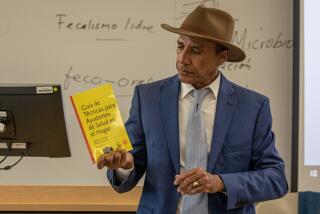Center for International Commerce : Worldly Students Put Their Stock in Trade
LONG BEACH â Three busloads of teen-agers got personally acquainted with a 60-foot pile of salt recently.
âIt looks like it would be fun to roll around in,â commented Stephanie Shiffer, 15. âExcept that youâd have salt in your ears.â
The white stuff--120,000 tons of it stacked as high as a small mountain--was sitting in a yard at the Port of Long Beach awaiting shipment by the Ocean Salt Co.
The teen-agers--175 of them--were touring the port as part of a Long Beach Unified School District program designed to teach them about more than just salt.
Itâs called the Center for International Commerce. And according to school officials and members of the Southern California business community, itâs an innovative way, perhaps unique in the country, of preparing high school students for lives and careers in the 1980s.
âAn International Cityâ
âItâs appropriate (for this area) because Long Beach is really an international city with a major port,â said Greta McGree, founder and facilitator of the program based at Long Beach Poly High School. âThis is really the gateway to the Pacific Rim.â Within 10 years, she said, âwe will be a major world trade area.â
In operation since 1981, the rigorous four-year curriculum is designed to prepare students for careers in international commerce. Although originally conceived for students planning to enter the job market immediately after graduation, McGree said, the program now attracts and serves primarily college-bound students.
Beginning as ninth graders, students take courses in world geography, global economics, diplomatic history, international marketing, international maritime law, world finance and maritime insurance as well as their regular high school classes.
McGree said they also study Spanish, Mandarin Chinese, Japanese or Russian. While Poly students donât need to take a foreign language to graduate, she said, students in the Center for International Commerce who wish to complete the program are required to take three years of the same language and encouraged to take four.
âWe want them to start thinking globally,â said McGree, 46, who has a degree in business administration and worked in marketing before becoming a teacher 12 years ago. âWe want them to realize that life doesnât end at the boundaries of Long Beach--that we are part of the world. We want them to have a broader perspective.â
Visited World Trade Center
Besides touring the port, she said, students in the program have visited Little Tokyo and the World Trade Center in Los Angeles, walked through a Customs office and a Toyota plant and been escorted through a Chinese container ship.
Though any Long Beach ninth grader with at least a C average may apply for admission, she said, not all are accepted. âIâm looking for kids who arenât afraid to (try) something different,â McGree said. Of the more than 200 students who apply each year, she said, only about 150 are admitted. Those who become part of the program are bused each morning from their home schools to Poly for four hours of instruction, she said. In the afternoons, they have the option of returning to their home schools or finishing the day at Poly.
Of the 65 students who graduated from the program last June and the 300 now enrolled, 75% came from schools other than Poly, she said. Upon graduation from the Center for International Commerce, she said, each is awarded a certificate attesting to the special preparation. Although the certificates have no official standing at universities or in industry, some employers familiar with the program say they would pay attention to one in the hands of a potential recruit.
âThese people are only about five years away from the marketplace,â said Elmar Baxter, public information officer for the Port of Long Beach, which, he added, will be needing more knowledgeable workers in the years ahead. âThis area is expanding so quickly that unless some training goes on, there wonât be any expertise in a few years.â
In organizing the program, McGree visited three similar but less extensive school programs in the East: two in New York and one in Minneapolis. Since its inception, she said, the Long Beach program has attracted serious attention--including personal visits--from representatives of school districts as far-flung as San Diego, San Francisco and Alaska.
Program Called Model
Dan Young, the Los Angeles district director for the U. S. Department of Commerce International Trade Administration and executive secretary of the Southern California District Export Council, said the council made presentations on the program at two national conferences in Washington, D. C.
In fact, he said, the presentations generated such interest that last month the council published and distributed a booklet based on the Long Beach experience to the 51 district councils nationwide. Entitled âExport Promotion: An Educational Initiative,â the document held the Poly program up as a model for emulation, he said.
âIt gets people at the high school level geared up to think in terms of international trade,â Young said of the program. âItâs a model that people can look at and adapt to their own circumstances.â
Not all of the students, of course, are as high-minded in their motivations.
Emily Yonis, 15, said she entered the center because she wasnât accepted into a program for high achievers--and because being a student in the commerce program âis like youâre privileged.â
âRegular school is boring,â said Yonis, who isnât sure what she wants to do with her life but knows she will most likely work in Long Beach and have nothing to do with computers.
âMore Challengingâ
And Mona Bati, a 16-year-old student studying Russian and who wants to study fashion design in Paris, isnât sure how the program will help her do that. But she likes the program anyway, she said, because itâs interesting and âmore challenging than being in a regular class.â
Many of the students, however, said they saw direct connections between what they were studying in school and their career plans.
Brian Hund, who wants to practice international law, said the center will help him get some âinternational connections.â And Victor Benavides has a very specific career aspiration which he said he arrived at during a course in international banking. His goal: to work in the international currency department of the new World Trade Center to be built in Long Beach.
Teachers and parents say they are encouraged by the studentsâ enthusiasm for the program. Although it is still too early to track last yearâs graduating class--the centerâs first--plans are being made to do an eventual follow-up, McGree said. She also is developing an internship program to place seniors in temporary jobs in international commerce and related fields. So far, she said, 12 students have been placed.
But the real clincher for some seemed to come while spending a sunny Southern California morning touring the harbor by foot, bus and boat. âI wanted to work in the port ever since I was a little kid,â said Mike Allen, 15, staring dreamily over the side of the tour boat as it cruised past a dock piled with empty shipping containers. âMy uncle worked in the port.â The Center for International Commerce âis making my dreams come closer to reality.â
More to Read
Inside the business of entertainment
The Wide Shot brings you news, analysis and insights on everything from streaming wars to production â and what it all means for the future.
You may occasionally receive promotional content from the Los Angeles Times.










